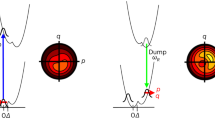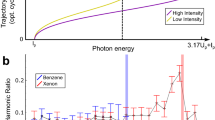Abstract
INFORMATION on macromolecules may conveniently be found by application of the Kerr electro-optic effect. When an electric field in the form of a pulse of rectangular shape is applied to a solution the molecules will attempt to line up to a state of minimum potential energy during the rise period of the pulse. Once lined up they will remain stationery in alignment when the field amplitude is constant and then become disorientated by Brownian motion when the field ceases. If the orientation is sufficient the solution will exhibit birefringence, but since large molecules will take time to come into alignment and to return to a state of random array the rise and decay of the birefringence will lag behind that of the applied field. In general, therefore, a gradual increase of birefringence occurs, which may or may not reach a steady value according to the duration of the pulse, followed by a decay. Observations of the rise can give information on dipole moments and the steady value can be related to the Kerr constant and to molecular anisotropy. The decay for a solution of k types of molecules occurs according to the equation1:  in which Δn is the birefringence at any time t, δni is the maximum birefringence shown by molecules of type i and τi is a relaxation time which is a measure of the time the molecule takes to depart from its position of minimum potential energy. If it be assumed that the effect of the field is to produce rotation of the entire molecule then the polar or non-polar nature of the molecule is made manifest by the symmetry or asymmetry of the birefringence rise and fall, and τi can be related1 to the rotary diffusion constant Di by the equation τi = 1/6Di. Values of relaxation times and diffusion constants obtained in this laboratory are reported here.
in which Δn is the birefringence at any time t, δni is the maximum birefringence shown by molecules of type i and τi is a relaxation time which is a measure of the time the molecule takes to depart from its position of minimum potential energy. If it be assumed that the effect of the field is to produce rotation of the entire molecule then the polar or non-polar nature of the molecule is made manifest by the symmetry or asymmetry of the birefringence rise and fall, and τi can be related1 to the rotary diffusion constant Di by the equation τi = 1/6Di. Values of relaxation times and diffusion constants obtained in this laboratory are reported here.
This is a preview of subscription content, access via your institution
Access options
Subscribe to this journal
Receive 51 print issues and online access
$199.00 per year
only $3.90 per issue
Buy this article
- Purchase on Springer Link
- Instant access to full article PDF
Prices may be subject to local taxes which are calculated during checkout
Similar content being viewed by others
References
Benoit, H., Ann. Phys. (France), 6, 561 (1951).
Badoz, J., J. Phys. Radium (France), 17, 143A (1956).
Cohn, E. J., and Edsall, J. T., Proteins, Amino Acids and Peptides (Reinhold, New York, 1943).
Ingram, P., and Jerrard, H. G., Sci. Prog., 59, 651 (1961).
Author information
Authors and Affiliations
Rights and permissions
About this article
Cite this article
INGRAM, P., JERRARD, H. Measurement of Relaxation Times of Macromolecules by the Kerr Effect. Nature 196, 57–58 (1962). https://doi.org/10.1038/196057a0
Issue Date:
DOI: https://doi.org/10.1038/196057a0
Comments
By submitting a comment you agree to abide by our Terms and Community Guidelines. If you find something abusive or that does not comply with our terms or guidelines please flag it as inappropriate.



